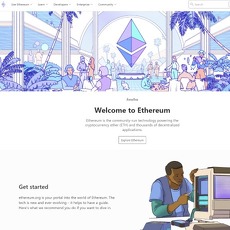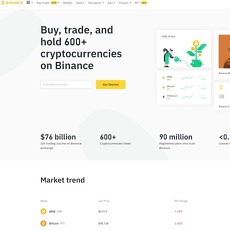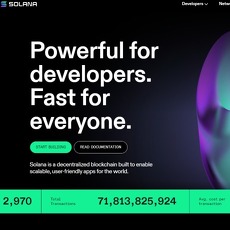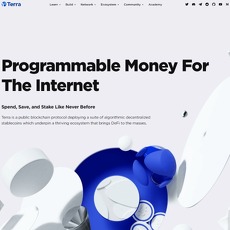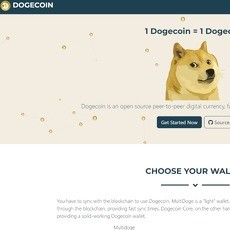XRP (Ripple) Review
XRP (Ripple)
xrpl.org
XRP Website Review
- XRP is a digital asset that is specifically built for digital payments.
- XRP aims to be an alternative when it comes to processing international transactions.
- The XRP ledger is a scalable and sustainable blockchain network.
- It is a decentralized, public blockchain that is led by a global developer community.
XRP is the token that is used across the XRP Ledger (XRPL), which is a fast, energy-efficient, and reliable decentralized blockchain network.
The main goal for its development was to enable low transaction costs, as well as a knowledgeable community, as it provides developers with a strong, open-source foundation when it comes to the execution of the most demanding projects, all without hurting the environment.
Today, we are going to go over just about everything that you need to know when it comes to the XRP project, the cryptocurrency, website, and overall functionality surrounding it, after which we will go over the pros and the cons associated with it.
XRP Website
The very moment you visit the XRP website for the very first time, you are greeted by a giant "X" symbol, which is circled by the faces of many different people. This could be a call toward the fact that the XRP ledger aims to connect people and that it is a community-powered utility.
However, we will start with the navigation bar first. On the top side of the screen, you will find the XRP LEDGER logo, where the text is written in caps, and right next to it, you will be able to see the about sections, the docs section, and the community section.
Right next to it, on the right side of the screen, you will be able to view a huge search bar, which will allow you to search for anything on the website. You will also see a "sun" icon on the far right corner of the screen, and once you click on it, you will activate the dark mode of the website. The official website does indeed feature a dark mode, and once it has been activated, you will be able to see how the icon shifts to a moon icon which is an excellent touch.
Right underneath it, you have a large “Start Building” button that will take you to a page where you can learn a lot of things surrounding the XRP Ledger through its official documentation.
Within this page, you can browse a multitude of different topics, including:
- Send XRP
- Reserves
- XRP Faucets
- Run rippled as a Validator
- Build and Run rippled in Reporting Mode
- Introduction to Consensus
- Public rippled Methods
This is a solid setup process that will help just about anyone, no matter what kind of level of experience they have, get comfortable with using the website as well as the ledger.
In any case, when we move down the main, official page, we are greeted by more information surrounding the service.
Specifically, we are introduced by the fact that the XRP ledger is described as a scalable, sustainable blockchain network.
The XRP Ledger website provides us with specific benefits. We are essentially introduced to why developers are choosing the XRP Ledger to develop on top of. Some of the specific, highlighted benefits include the following:
- Public and Decentralized Structure - here, the website teaches us how the project is open-source, which means that it is completely open to anyone to build on and is maintained by community members.
- Streamlined Development - this section of the website gives us an indication that tools exist and documentation is written as a means of speeding up the development process and reducing the overall time-to-market.
- High Performance - here, we get an indication that the XRP Ledger is capable of setting thousands of transactions within the span of seconds.
- Low Cost - XRP ledger claims that it can conduct transactions at fractions of a penny per transaction, where the costs are inexpensive enough that they enable a wide variety of use-cases as a direct result.
- Vibrant Community - Here, we get an indication that the developers, validators, users, and businesses make the XRP ledger larger on a daily basis.
- Proven Reliability - Here, they claim that XRP Ledger provides a consistent level of performance to over 63 million ledgers.
Underneath that specific section of the page, we are introduced to some advanced features surrounding the XRP ledger. Specifically, the website introduces each visitor to "activate the true potential of the XRP Ledger."
Specifically, it advertises numerous advanced features, such as the following:
- Decentralized Exchange - this is a high-performing decentralized, peer-to-peer multi-currency exchange that is built directly into the blockchain.
- Cross-Currency payments - what this means is that it can automatically settle multi-hop payments that cross-currency or national boundaries efficiently.
- Payment Channels - what this means is that it can conduct batched micropayments with unlimited speed, all of which are secured with XRP.
- Multi-Signing - this offers flexible options when it comes to custody and security of on-ledger accounts.
- Tokens - what this indicates is that all currencies other than XRP can be presented within the XRP Ledger as tokens.
Right underneath that specific portion surrounding the page, you are introduced to the “Get Started” section, which gives you a clear path towards which you can start building on the XRPL.
Here, you get a quick start guide, access to guided tutorials, information about the XRPL fundamentals, the ability to pick from multiple programming languages and to get inspired.
You can also review the shared vision for XRPL's future. Near the bottom of the page, there is also a showcase of what the community is building as a means of enabling new features and use-cases of the XRPL, such as smart contracts and non-fungible tokens (NFTs) and sidechains, all of which are in development. The page ends by inviting you to get involved with a large "Join the Community'' button.
That's everything surrounding the main XRP page; now, we will be going over its history and overall functionality.
History of XRP
Prior to going over the functionality, we need to get one thing out of the way. There is a common misconception that Ripple is a cryptocurrency. Ripple itself is not a cryptocurrency.
RippleNet is a platform that was developed in 2012 as a means of offering banks and financial institutions a real-time gross settlement system, which led to secure and instant financial transactions on a global scale, but Ripple is a completely independent and separate company from XRP.
Ripple is a San Francisco startup company that develops software that then gets used by banks as a means of facilitating quick and global financial transactions. XRP is a digital asset built for payments. XRP exists without Ripple.
What this means is that anyone that downloads and runs the XRP Ledger can become a validator, and the XRP Ledger can live on, even if Ripple goes away as a company. Ripple did not issue and currently does not oversee XRP; it is just a single part of a much broader ecosystem.
With all of that cleared up, the company was originally founded in 2012 by Chris Larsen and Jed McCaleb and is based on the work of Ryan Fugger, who originally created the XRP Ledger in 2012.
The XRP Ledger was developed to be an open-source, cryptographic ledger that is powered by a peer-to-peer network of nodes. McCaleb ended up leaving Ripple and founded Stellar, which is another payments-oriented cryptocurrency.
Functionality
When it comes to the functionality surrounding XRP and the XRP Ledger, it is essentially a decentralized public blockchain. What this means is that anyone is given the opportunity to connect their computer to the peer-to-peer (P2P) network, after which they can contribute to the management of the ledger. The overall global XRP Ledger community, which is a diverse set of software engineers, server operators, users, and businesses, maintains this ledger.
However, to power all of this and make all of this work, XRPL utilizes a consensus protocol that is specifically designed to have designated servers that are called validators and come to an agreement on the order and overall outcome of XRP transactions throughout every 3 to 5 seconds.
All of the servers in the network have the ability to process each transaction in accordance with the same rules, and any transaction which follows the protocol can get confirmed right away. Furthermore, all of the transactions here are public and have strong cryptography, which guarantees the integrity of the system.
Anyone is given the opportunity to operate a validator, and there are over 150 validators active on the ledger. Many of them are operated by universities, exchanges, businesses, and individuals. Furthermore, the consensus protocol even ensures that the blockchain can become a lot more decentralized over time as the validator pool grows.
Furthermore, in contrast to competing blockchain networks, the XRP Ledger does not use a Proof-of-Work (PoW) consensus mechanism, nor does it use a Proof-of-Stake (PoS) consensus mechanism.
It utilizes the XRP Ledger Consensus Protocol, which was specifically developed to be a more centralized and efficient solution that reduces transaction finality time, and transaction costs. With the XRP ledger, transactions can be completed within the span of a few seconds as a result of this, which is much quicker than the ten-minute block time found in the Bitcoin (BTC) cryptocurrency network, or traditional payment systems such as SWIFT, for example.
Pros and Cons of XRP
Pros XRP
The transactions that occur with XRP are quick and cheap.
XRP can be utilized by small business owners and customers for secure money transfers.
XRP is also used as a bridge currency for international currency transfers.
Cons XRP
- The XRP Ledger is not as decentralized as competing projects.
- There is a strong rivalry when it comes to this project.
The Bottom Line
The XRP Ledger (XRPL) provides a powerful utility when it comes to the blockchain space as a whole. This is due to the fact that the ledger features unique properties, such as the fast and efficient consensus algorithm, as well as the censorship-resistant transaction processing, all of which are leveraged by thousands of developers, which makes it a unique and interesting project.
The website is designed efficiently, which showcases the information that each user needs at the point in time when they need it, and you are not thrown or overwhelmed with too much information.
Through the utilization of XRPL, developers are building innovative projects as well as applications across blockchain use-cases, which include tokenization of assets, online gaming, non-fungible tokens (NFTs) as well as Decentralized Finance (DeFi).
Frequently Asked Questions (FAQs)
Is XRPL A Private Blockchain?
The XRP Ledger is a decentralized, public blockchain network. What this means is that any changes that would impact the transaction processing or consensus need to be approved by at least 80% of the network.
Is XRPL Used Only for Payments?
While XRPL was initially only developed as a means of facilitating payment use-cases, both the ledger as well as the native cryptocurrency, known as XRP, are increasingly gaining popularity in a wide range of innovative blockchain use-cases. These new standards proposals for issuing NFTs, smart contract functionality, and federated side chains are all currently in progress and in development, which means that over time, XRPL will not only be used for payments.
What Is the Role of Transaction Validators?
All of the nodes ensure that the transactions that occur meet all of the protocol requirements and are, as a result of that fact, fully "valid." The service that the validators uniquely provide is administratively grouping transactions within ordered lists, as well as agreeing on one such ordering specifically to prevent what is known as double-spending.
How Much Does It Actually Cost to Run a Validator?
Running a validator does not require any fees to be paid or any XRP tokens. This is comparable in cost to run an email server in terms of the amount of electricity that it requires to be functional.
The XRP Ledger (XRPL) and its native token, XRP, are redefining digital payments with a scalable, energy-efficient, and decentralized blockchain that delivers lightning-fast transactions at fractions of a penny. Its developer-friendly ecosystem, robust consensus protocol, and vibrant community make it a powerhouse for innovative use cases like DeFi, NFTs, and cross-currency payments. While it faces challenges like perceived centralization and competition, XRPL’s proven reliability and user-focused website design solidify its place in the crypto landscape. Ready to explore XRP’s potential and beyond?
Dive deeper into XRP and other transformative blockchain projects at CryptoLinks.com, where you’ll find expert reviews, trusted resources, and the latest insights to fuel your crypto journey. Explore now and unlock the future of decentralized finance!



